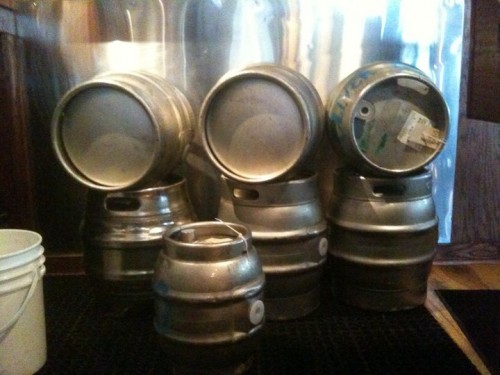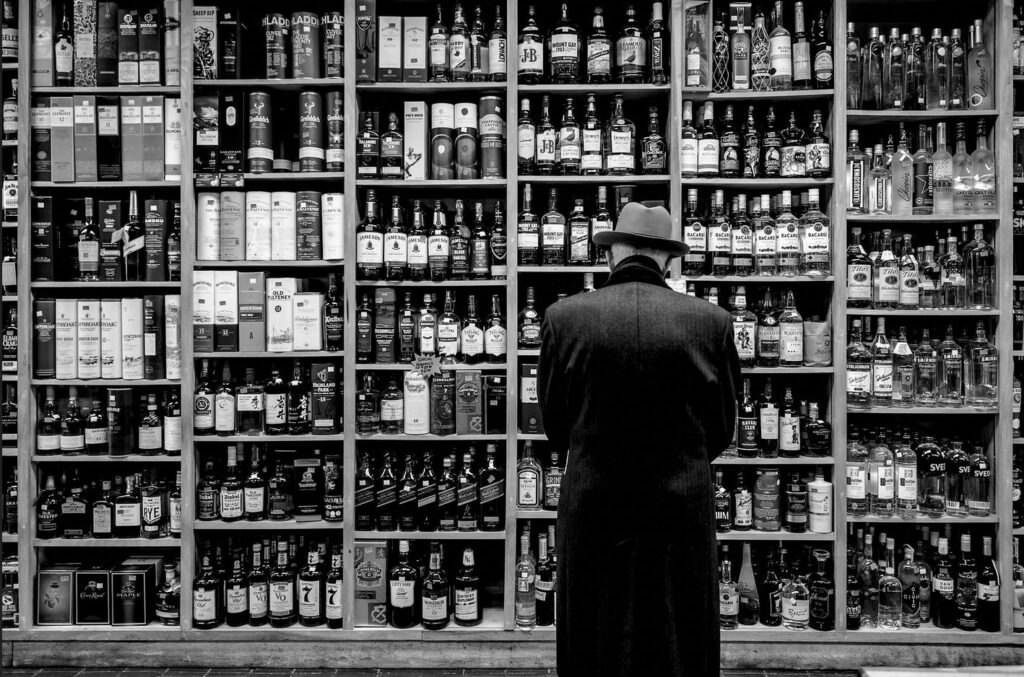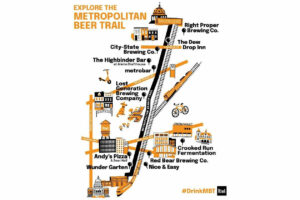
Sam Fitz is a Certified Cicerone® and the Beer Director at Meridian Pint and Smoke & Barrel.
Cask Beer: The Perfect Fit for PoP’s 5-Year
Beer, like most products these days, has been drastically transformed, for better or worse, by modern innovation. The way in which it is now made, stored, and served is markedly different from a century ago. This evolution has changed the very nature of beer. Super-cold and effervescent are appropriate descriptors for the overwhelming majority of brews you’re likely to encounter today, including craft beer, but these would be wholly inappropriate for most of the beers offered just one century ago. Draft systems were nonexistent then and the pub specialty the world over was cask beer, naturally carbonated and served close to room temperature. It may not seem like a big deal, but the transition from casks to kegs transformed beer into something related but distinctively new. It’s kind of like dinosaurs and birds.
Cask beer is brewed and primarily fermented like any other beer. During fermentation, yeast converts sugars into carbonation, which is eventually allowed to escape, and alcohol, which is obviously retained. Draft beer is then filled into kegs and force-carbonated with compressed gas. Before this was possible, brewers had to utilize yeast’s naturally ability to make bubbles. Casks, created from wood or metal, are filled with flat beer that is pitched with a second dosing of yeast and sealed. As the cask “conditions”, the yeast consumes residual sugars and carbonates the vessel. For serving, a faucet is hammered into the cask, and it is either gravity poured or hooked up to a beer engine that pulls the brew out of the cask with pressure applied by a hand pump.
Forced carbonation in draft beer produces small bubbles that are uniform in size and have a particular propensity to lift lingering flavors off your tongue and cleanse your palate. The effect is refreshing, bubbly, and very useful in pairing with fatty foods. Lower temperatures help any liquid to retain its carbonation, so it’s no surprise that draft beer is usually sold very cold to maximize its refreshing capabilities.
Continues after the jump.
Natural carbonation from yeast in a cask results in a very complex head. Bubbles of all different sizes struggle amongst themselves to reach the nose, and the resulting froth resembles soap bubbles more than a tasty beverage. The varied and predominantly larger bubbles in cask beer may not be as refreshing or cutting as their smaller counterparts in a draft, but they do have a big advantage: the volatiles, aromatics present in any brew that desperately want to escape and invade your senses, are more easily propelled out of the beer and into your nose. Warmer temperatures induce increased movement in any molecule, including volatile aromatics, so it makes sense that cask beer is usually served at room temperature to intensify the aroma.
In 1973, after the world had predominantly moved from cask to draft beer, a small group of consumers in England lamented the change from soft, aromatic cask brews to sharp, cutting, cold draft beer. The Campaign for Real Ale (CAMRA) was formed around a definition of “real ale”: “beer brewed from traditional ingredients, matured by secondary fermentation in the container from which it is dispensed, and served without the use of extraneous carbon dioxide.” Real ale is a better term for this type of beer, as a cask is simply the container from which it is usually poured. Bottle-conditioned beer also fits the description and is considered real ale as well.
CAMRA fought hard to keep the dinosaur, real ale, alive in England. Although the battle has been arduous, much progress has been made. Though not as prevalent as it once was, you can still find good pints of cask beer throughout England, and even American brewers have become involved in the campaign. Traditional English beer styles like mild, bitter, and pale ale are best represented as real ale, as their delicate flavors and aromas (bready, nutty, grassy, earthy, fruity, etc.) are not masked by sharp carbonation. Rather, they are drawn out with warmer temperatures and natural carbonation. As brewers continue to experiment, more aggressive styles have evolved and are now being racked into casks.
American IPAs, with their huge citrus and pine flavors, are an aroma bomb on cask, but with less carbonation hop bitterness is reduced and the result is a very different beer–one which is much more approachable and palate-expanding with less bite. An imperial stout, high in alcohol and dark, roasty flavors, doesn’t taste like much when served close to freezing. Put it in a firkin (the most common cask size used today, 10.8 gallons) and serve it at 55 degrees and the depth of malt flavors will astound you. Even seasonal specialties, like the pumpkin beers that recently invaded the city, can be quite interesting as real ale.
Draft beer is usually kegged “bright”, meaning it has been fully conditioned and the majority of suspended particles have fallen out. Casks have an active fermentation within them and finings are added to naturally induce suspended particles to settle at the bottom. Even so, cask beer is perfectly acceptable with a little cloudiness to it. Accordingly, brewers can include extra ingredients, “dry-additions”, directly into the cask, allowing creativity to run rampant. Elderberries, juniper, peppercorns, mango and oak chips are among many accompaniments I’ve seen recently.
The most common dry-additions are hops, and when employed the process is called “dry-hopping”. Hops are usually added during the boil where bitterness is extracted and intensified by the heat. Volatile aromatics responsible for the lovely flavors on a beer’s nose evaporate and are lost. Dry-hopping extracts copious aromas from the hops without imparting much of any bitterness as the boil was completed long before. The effect on a beer is very enjoyable and surprising to many that fear the hop flower. An American IPA on cask will naturally seem less bitter and more aromatic than the same beer on draft due to the reduced carbonation, warmer temperature, and composition of the head. Dry-hopping only enhances this and is incorporated in some sinfully aromatic yet soft beers.
Drinking a fresh draft from a clean line is a pleasant luxury but, just because technology and innovation went into making this a reality, it doesn’t mean that cask beer is of any lesser value. Drinking real ale is a connection to the past and the way beer once was and I, for one, am thrilled that we are still afforded the opportunity.
Usually my pieces end with, you guessed it, a beer review. But today is the five-year anniversary of our champion-of-the-local, The Prince of Petworth. The neighborhoods he covers have changed quickly, from one thing to something else that is similar but distinctly different. Helping us make sense of our community evolutions is PoP. To honor The Prince, The Pint teamed-up with our local brewery, DC Brau, to showcase some brews that represent the old and the new. Four casks of The Public Ale will be pouring in the traditional way, but the Brau boys added good old American ingenuity, packing them full of Sorachi, Amarillo, Cascade and New Zealand Rakau hops. Mangos even made their way into two of the casks. So, instead of reading another beer review, come celebrate 5 years of The Beautiful Life with the Prince of Petworth and a cask at The Pint, and write your own.
Recent Stories

Photo by Beau Finley Ed. Note: If this was you, please email [email protected] so I can put you in touch with OP. “Dear PoPville, Him, dapper chap with a light…

For many remote workers, a messy home is distracting.
You’re getting pulled into meetings, and your unread emails keep ticking up. But you can’t focus because pet hair tumbleweeds keep floating across the floor, your desk has a fine layer of dust and you keep your video off in meetings so no one sees the chaos behind you.
It’s no secret a dirty home is distracting and even adds stress to your life. And who has the energy to clean after work? That’s why it’s smart to enlist the help of professionals, like Well-Paid Maids.

Unlock Peace of Mind for Your Family! Join our FREE Estate Planning Webinar for Parents.
🗓️ Date: April 25, 2024
🕗 Time: 8:00 p.m.
Metropolitan Beer Trail Passport
The Metropolitan Beer Trail free passport links 11 of Washington, DC’s most popular local craft breweries and bars. Starting on April 27 – December 31, 2024, Metropolitan Beer Trail passport holders will earn 100 points when checking in at the
DC Day of Archaeology Festival
The annual DC Day of Archaeology Festival gathers archaeologists from Washington, DC, Maryland, and Virginia together to talk about our local history and heritage. Talk to archaeologists in person and learn more about archaeological science and the past of our






